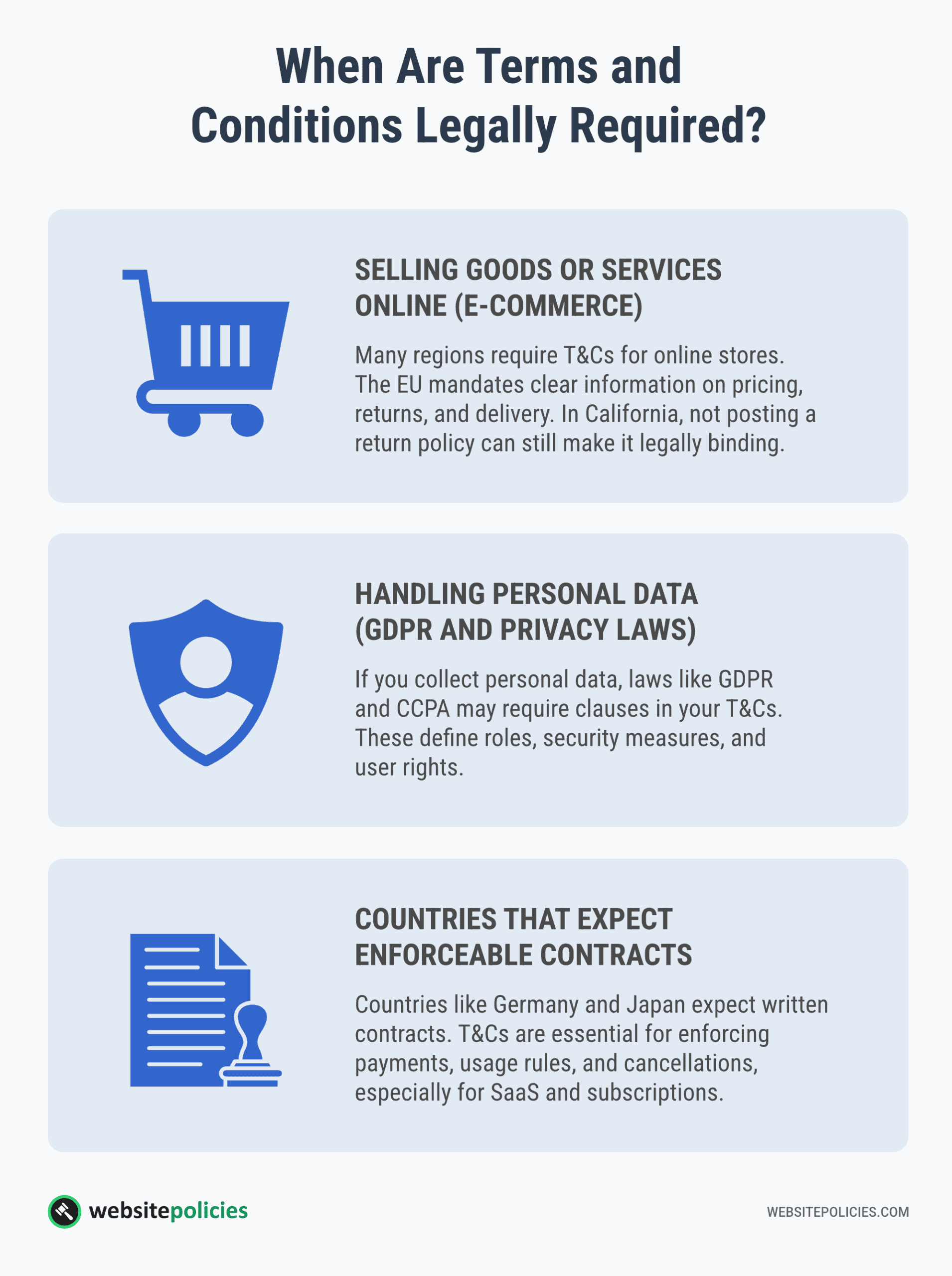You’ve probably skipped past those long “Terms and Conditions” pop-ups more times than you can count. Most people do. But if you’re running a business online and don’t have your own, that’s a real risk.
Many think T&Cs are just legal padding, nice to have, but not essential. The truth is, they’re one of the simplest ways to protect your business from legal headaches and financial losses.
Below, I’ll break down what terms and conditions actually do, whether you legally need them, and why they’re worth your time. No legal jargon, just clear, straightforward legal advice to help you stay protected.
- Even when not legally required, terms and conditions protect businesses from legal disputes, liability, and user misunderstandings.
- A well-written, easy-to-understand T&C page builds trust and can limit legal and financial exposure.
- T&Cs must be customized to your business, comply with local laws, and be clearly accepted by users to be enforceable.
Table of Contents
PRO TIP: Take the hassle of writing your own terms and conditions away with our terms and conditions generator trusted by over 200,000 businesses. It’ll save you hours of work and possible costly legal mistakes.
Are Terms and Conditions Legally Required for a Website?
No, terms and conditions (T&Cs) aren’t legally required, but they’re highly recommended if you want to protect yourself as a business owner.
There’s no law that says your site must have T&Cs. This isn’t like a privacy policy, which is mandatory if you collect personal data. But skipping T&Cs can leave you exposed to legal disputes, misunderstandings, and unhappy users.
T&Cs set the ground rules. They explain how your website should be used, what users can expect from you, and how you handle things like payments, cancellations, and account issues. Without them, you’re missing an important safety net.
They’ve also become the norm. In fact, about 97% of Americans say they’ve been asked to accept terms and conditions, which are usually tied to privacy policies. So not having one on your site can feel like a red flag to users and might make handling conflicts harder down the line.
PRO TIP: You don’t need a 20-page legal document. Even a short, well-written T&C page can help limit your liability and make sure everyone’s on the same page.
Let’s say you run an online store. T&Cs let you clearly state your return policy, how shipping works, and what happens if something gets lost. Without that, you’re left hoping everyone’s reasonable, and that’s a gamble in any business.
When Are Terms and Conditions Legally Required?
Technically, terms and conditions or terms of service aren’t required by law in most cases, but depending on how and where you do business, they can quickly go from optional to essential.
Here are a few situations where terms and conditions are legally required:

1. Selling Goods or Services Online (E-Commerce)
If you run an online store, many regions require you to clearly outline things like pricing, returns, cancellations, and delivery terms.
Take the European Union, for example. The Consumer Rights Directive (2011/83/EU) says you must give customers detailed information before they buy. If you don’t, a customer could legally cancel an order or demand a refund, regardless of what your site says.
In the U.S., there’s no federal law forcing you to have T&Cs, but states like California have strong consumer protection laws. If your return policy isn’t clearly posted, you could still be required to honor one.
2. Handling Personal Data (GDPR and Privacy Laws)
If your website collects or processes personal data, especially from users in the EU, you may be legally required to include specific clauses in your T&Cs or other legal agreements, like terms of use.
Under the General Data Protection Regulation (GDPR), for example, Article 28 requires that data processors follow a written contract outlining roles, responsibilities, and security measures.
Even in the U.S., laws like the California Consumer Privacy Act (CCPA) expect businesses to spell out consumer rights. While this is usually handled in a privacy policy, key terms often appear in T&Cs, too, especially if they affect how services are used.
3. Countries That Expect Enforceable Contracts
In places like Germany, France, and Japan, courts often expect formal written agreements in case of disputes. If you’re offering a SaaS platform or subscription-based service, then your terms and conditions are legally binding agreements.
Without one, enforcing things like payment terms, usage rules, or cancellation policies can be much harder, especially if your customer is overseas.
When Are Terms and Conditions Optional?
Terms and conditions are optional when no specific law requires them, but that doesn’t mean you should skip them.
If you’re running a personal blog, a portfolio site, or a free app that doesn’t collect personal data or sell anything, you’re not legally required to include T&Cs. But leaving them out can still leave you open to unnecessary risks.
Here are some common situations where terms and conditions agreements aren’t mandatory but are still a smart move:
- Informational Sites or Personal Blogs: If your site doesn’t sell anything, collect data, or require user accounts, you’re in the clear legally. Still, T&Cs can help protect your content and limit your liability if someone misuses what you publish.
- Free Mobile Apps: Apps that don’t collect user data or offer in-app purchases usually aren’t required to have T&Cs. That said, platforms like the Apple App Store and Google Play recommend them, especially to set boundaries, disclaim liability, and protect your rights as a developer.
- Basic Business Websites Without Transactions: Even if your site just lists your services and doesn’t handle payments or personal data, T&Cs can still serve a purpose. They help clarify how visitors should interact with your site and what’s off-limits.
Even when they’re not legally required, T&Cs come with real benefits.
- They create enforceable rules. Courts are more likely to support your position if users break clearly stated terms, especially if they agreed by clicking a button or continuing to use your service.
- They help prevent abuse. You can ban things like spamming, copying content, or using your materials without permission.
- They promote transparency. Users know where you stand on key issues like account bans, content rights, or service updates.
Just because you’re not required to have T&Cs doesn’t mean you shouldn’t. Even simple ones can give you peace of mind and help avoid misunderstandings.
What Happens if You Don’t Have Terms and Conditions on Your Website?
Not having terms and conditions on your website leaves you vulnerable in more ways than one. They’re not just legal fine print, they’re a protective layer for your business when things go sideways.
Here are the biggest risks of going without:
1. You May Have No Legal Standing in a Dispute
If a customer misuses your site or refuses to pay, your ability to enforce anything depends on whether you had clear terms in place. No T&Cs often means no enforceable contract, and that can sink your case in court.
For example, in Nguyen v. Barnes & Noble Inc. (2014), the court ruled that a user wasn’t bound by the site’s terms because they never clicked to accept them. Without proof of agreement, the company had no legal ground to stand on.
2. You Could Be Liable for What Users Do
If someone uploads copyrighted material, posts something illegal, or misuses your platform, and you haven’t set any boundaries, you could be held responsible.
A small forum was sued in 2020 when users shared copyrighted content. Without T&Cs or a content policy, the owner couldn’t claim protection under the DMCA safe harbor, leaving them open to liability.
3. You Can’t Limit Your Liability
T&Cs typically include a “limitation of liability” clause that helps reduce your exposure if things go wrong, like a service outage or a third-party failure. Without that, you may be fully on the hook for damages.
PRO TIP: Always include a clear limitation of liability clause. It won’t prevent lawsuits, but it can limit how much you’re responsible for.
4. Payment Disputes Are Harder to Win
If you sell online without clear terms for refunds, shipping, or cancellations, you’re more likely to lose payment disputes. Payment processors often side with customers if your policies aren’t easy to find or clearly stated.
5. You Lose Trust with Users
Even if you never face a legal issue, not having T&Cs can make your business look disorganized or, worse, untrustworthy. Clear terms show users that you’re serious, transparent, and prepared.
How to Ensure Your Terms and Conditions Are Compliant
Having a “Terms and Conditions” page isn’t enough, it’s about having the right terms in place for your business. That means ditching the generic templates and making sure what you publish is legally sound, up to date, and written in a way people can actually understand.
Here’s how to do it right:
1. Match Legal Requirements to Your Business and Region
The laws that apply to your T&Cs depend on what you do and where your customers are.
- Selling to the EU? You’ll need to follow the Consumer Rights Directive and GDPR.
- Operating in the U.S.? You may fall under the Uniform Commercial Code (UCC) and state-level e-commerce laws.
- Targeting California residents? Make sure you’re covered under the CCPA and the California Business and Professions Code.
If your T&Cs don’t reflect the right laws, they might sound official, but they won’t protect you when it matters.
2. Use Clear, Simple Language
Overcomplicated legal wording can do more harm than good. If users can’t understand your terms or don’t know they exist, enforcing them becomes much harder.
I’ve personally rewritten legal policies for small businesses that were too complex to be useful. The clearer we made them, the fewer support questions they got, and the easier it was to resolve disputes.
A study by Georgetown University found that even legal professionals understood plain-language documents better than legalese. When comparing two versions of the same bill, readers processed the plain English version faster and with nearly 20% more accuracy.
In short, simpler language helps everyday users and benefits everyone.
3. Keep Your Terms Updated
Laws change. So does your business. Whether you’re adding new services, changing how you collect data, or expanding into new markets, your T&Cs should reflect those updates.
PRO TIP: Review your terms every 6 to 12 months or any time your service, pricing, or data practices change. It’s one of the easiest ways to stay protected without hiring a lawyer every time.
4. Make Acceptance Clear
It’s not enough to just have terms. They need to be presented in a way that makes them legally binding. Courts tend to reject terms that users never clearly agreed to.
Use checkboxes like “I agree to the Terms” at checkout or sign-up, and always link to your T&Cs in a spot that’s easy to find.
5. Use Policy Generators (When It Makes Sense)
If you’re not ready to hire a lawyer, you’re not alone. Most businesses aren’t, especially when they’re just getting off the ground or need something affordable but effective.
That’s where a good generator comes in. The right one helps you build tailored terms based on your industry, region, and how your website actually works. No fluff. No copy-pasting from random templates. Just something that fits and actually protects you. And in most cases, that’s all you need to get your terms and conditions in place without overthinking it.
Frequently Asked Questions
Do I need terms and conditions on my website?
No, they’re not legally required, but they offer critical legal protection and clarify user expectations.
Are terms and conditions legally required for all types of businesses?
No, but certain industries and regions may mandate specific disclosures or terms, especially for e-commerce and data handling.
Do I need terms and conditions for my online store?
Yes, especially if you sell in regions like the EU or California, where consumer protection laws apply.
Are terms and conditions legally binding?
Yes, if users clearly agree to them, such as by clicking an “I agree” checkbox.
Do I need to update my terms and conditions regularly?
Yes, review them every 6–12 months or whenever your business, laws, or services change.



